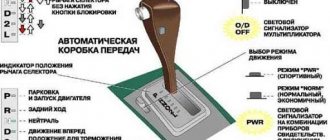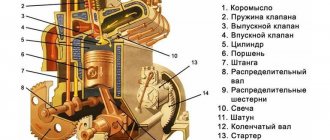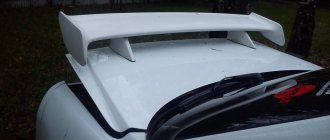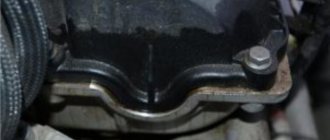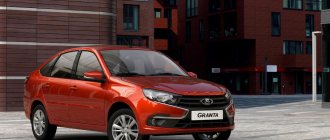Maintaining a safe distance when driving a vehicle is one of the basic skills. Every driver must own one. The traffic rules do not have a clear definition of distance and methods for calculating it, so this topic raises a large number of questions and disputes. What distance should be between cars to avoid an accident? What does it depend on? Do weather conditions and traffic volume affect the safe distance between vehicles? What penalties are provided by law for violation? In what cases are they used? All these questions are answered in our article.
How much will you have to pay to the state?
The amount of the fine for failure to keep the distance in 2021 may be 1,500 rubles.
It is this amount that is indicated in Code of Administrative Offenses 12.15 part 1, namely:
Any violations in the form of traffic moving on the side of the road, failure to maintain distance between cars. Also, the location of vehicles on the roadway, crossing a transport or pedestrian column and driving on an oncoming crossing may be punishable by administrative liability in the form of a fine in the amount of 1,500 rubles.
Sometimes conflict situations arise when tinting rear brake lights. Which, by the way, has become widespread lately. The situation looks like this:
2 cars are moving. The second motorist crashes into the first one because the first one has rear brake lights hidden under tinting. Because of this, the driver of the car moving behind makes a collision. According to the Code of Administrative Offenses, the second driver will be at fault for the accident. Also, studded tires will not be able to exempt you from paying a fine.
However, if it can be proven that the driver in front did not take measures to change the tires, the fine for failure to keep the distance is often divided in half in court.
But this is only if the “STUDDED TIRES” sign was not displayed on the car. Otherwise, no relief will occur and the fine will have to be paid in any case and in full.
As for the “SPIKES” sign itself, its absence, oddly enough, is not a violation in principle, but as practice shows, its presence can help out the car owner and partially mitigate the punishment, or completely help evade liability.
The average braking distance of a passenger car driving on a dry, level surface at a speed of 60 km/h is 15 m. However, in urban conditions it is impossible to maintain this distance.
A dense flow of cars starts immediately after the green traffic light, and the distance is less than 2 meters. Every driver expects that the car in front of him will not brake. In order not to rely on chance, you need to know the safe distance to the next car.
What is the penalty according to the law?
There is no specific fine for failure to comply with the lateral interval and distance in the current laws. This question relates to the section where the Administrative Code deals with the location of cars on the road. And it contains a fine for these violations - Art. 12.15 part 1, which provides for a fine of 1,500 rubles.
It cannot be imposed by a traffic police officer during a routine stop of a driver. Such a violation is charged only in the event of a traffic accident when the lateral interval or distance is violated.
But in case of an accident, along with a fine, other penalties are also often imposed. For example, violating the distance often leads to an accident with harm to health or death of the victims. They may be considered passengers in the culprit's car. In this case, another penalty is imposed under Art. 12.24 of the Administrative Code - deprivation of rights, or even criminal liability.
Responsibility for failure to comply with lateral spacing
Distance between cars
The Code of Administrative Offenses contains penalties applicable to a motorist who does not comply with the lateral interval.
In accordance with the requirements of this regulatory legal act, violation of the rules for placing a vehicle on the roadway, driving along the side of the road or crossing an organizational pedestrian or transport convoy entails holding the motorist accountable in the form of a fine of 1,500 rubles.
In this case, the driver of the vehicle must remember the need to comply with some additional rules:
- The interval is considered safe until the actual collision occurs. Therefore, traffic police officers do not have the right to bring a motorist to administrative responsibility before the occurrence of a traffic accident.
- Traffic police officers do not have the right to fine drivers if the damaged vehicle was parked.
In 2021, a bill was introduced proposing to increase the fine for such an offense to 5,000 rubles. At the moment it is still under consideration, but it is expected that changes to the legislation will be made in 2017.
If traffic inspectors bring a motorist to justice without the fact of a traffic accident, this is considered a violation of the Code of Administrative Offenses. Such a decision can be appealed within 10 days from the date of receipt.
The motorist can also appeal this document if it was received in addition to the accident certificate. An appeal is only allowed if the driver believes that the accident occurred for another reason.
Documents confirming the motorist’s opinion must be attached to the complaint. This may be written testimony from witnesses, video or photographs of the incident, which shows that the cause of the accident was another violation of traffic rules.
Distance between cars in traffic rules
How to park in reverse between cars
Traffic regulations do not determine the required distance between cars in meters
Clause 9.10 states
9.10. The driver must maintain such a distance from the vehicle in front that would allow him to avoid a collision, as well as the necessary lateral interval to ensure traffic safety.
Two Second Rule
In practice, instructors advise keeping your distance according to the 2-second rule. To do this, you need to notice when the car driving ahead reaches something stationary. This could be a pole or a road marking. Count one thousand one, one thousand two, and your car should align with this landmark.
Why 2 seconds? The driver's reaction time to an unexpected situation just to understand what is happening is on average 1 second. And you still have a second to do something.
So that you can feel what 2 seconds is in real terms, below is a table showing the dependence of distance on speed. Dry numbers of meters can become clearer if you imagine the distance in standard cars. In the last column, the two-second distance is calculated in the most popular Hyundai Solaris cars, the length of these cars is 4.4 meters.
and a standard truck is 16 meters.
At a speed of 100 km/h, more than 12 Solaris or more than 4 buses or more than 3 trucks should fit between you and the vehicle in front. Then you will have a great chance of getting out of unexpected situations alive and unharmed.
Vehicle speed km/h
Travels meters in 1 second
Travels meters in 2 seconds
Length in Hyundai Solaris units
What affects driver reaction time?
Women, older people and tired drivers have longer than average reaction times. Also, reaction time increases for all drivers in bad weather and at night. This means that in such conditions the distance must be greater than usual.
The video below perfectly shows what can go wrong when the distance to the car ahead is not 13 Solaris, but 2 times less.
Braking distances
Only after the car has driven at a speed of 100 km/h for an average of 28 meters will the driver react to a sudden event and begin to take some action. If the driver decides to brake, the braking distance will begin. The braking distance can be 40 or 50 or even 200 meters if there is ice on the asphalt. Below are several tables and figures that will give you an idea of how far a car can travel after emergency braking.
How to control your distance
The distance ahead depends only on you. If you are overtaken and the distance is not comfortable, slow down and restore the distance again
The distance behind depends on you to a lesser extent, but is also 80 percent under your control. Firstly, you need to constantly monitor the distance behind you and if you see that someone is “on your tail,” apply the following actions.
1) Let the rusher pass - after changing into another row, if there is only one row, press to the side of the road
2) If the actions from the previous point are impossible - a very narrow road, a very dense flow, increase the distance in front. So that you always have room to maneuver
3) In very rare cases, you can speed up - suddenly you “fell asleep” in the left lane and are really slowing down. If a higher speed is allowed and is comfortable for you, add gas. Sometimes this can help restore the rear distance to normal.
However, in the overwhelming majority of cases, the rusher will not lag behind you and will stay just as close only at an even higher speed. In this case, do your best to give way to him, as this behavior indicates that the driver behind is unbalanced and does not think about his safety and the safety of others. Therefore, it is better to get rid of such a neighborhood.
Lateral distance control
Avoid being in the blind spots of other vehicles and make sure that there is no one in your blind spots either. The only exceptions can be when driving in a traffic jam, where it is almost impossible to comply with this rule. In other cases, in order to avoid getting into blind spots, speed up, slow down or change lanes. The more free space you have, the more time you have to maneuver in an emergency and the correspondingly higher your safety. The car in the video violated this rule and drove itself into a space where no maneuvers other than braking are possible, and since the front distance also did not correspond to the speed, the double mistake led to a sad but natural result for such driving.
The article was written based on materials from the sites: www.zr.ru, ru-act.com, avtotonkosti.ru.
Arbitrage practice
- The decision in case No. 12-67/2013 in Tatarstan upheld the driver’s complaint that she was illegally fined for violating paragraph 9.10 of the traffic rules when she was moving in reverse and collided with a stationary car. There are as many as 2 inconsistencies with the conditions of 9.10: the victim’s car did not move, it was behind, and not in front of, the car of the person responsible for the accident.
- By Resolution No. 5-18/2013, the Oryol Region Court dismissed the case of a driver who allegedly drove into a walk-behind tractor in violation of 9.10, without keeping a distance. The case was dismissed on the basis that the walk-behind tractor is not a vehicle, and the clause clearly stipulates that the distance must be maintained precisely from the vehicle moving in front.
- Verdict No. 1-6/2015 in the Tver region in a criminal case for causing the death of a cyclist due to failure to maintain distance from the driver of a car.
- Another decision canceling the fine for violating clause 9.10 on the basis that the offending driver was moving in reverse and collided with a standing car.
Comments on clause 9.10
money-trans.ru The difference between subrogation and recourse. What is the difference between recourse and subrogation under compulsory motor insurance. Cases of recourse in insurance
The driver must comply with:
the distance to the vehicle moving ahead, allowing to avoid a collision; the required lateral interval, ensuring traffic safety. The rules do not indicate the exact value of the safe distance, since it depends on:
technical condition of the vehicle; condition of the road surface; weather conditions; other factors. When driving in heavy traffic, it is necessary to predict possible emergency braking of the vehicle moving ahead and pay attention to the vehicle moving behind. Failure to maintain distance is the most common cause of collisions between vehicles moving in the same direction.
The distance is measured by the distance between vehicles following one another, and the higher the speed, the greater the distance. With a homogeneous traffic flow moving at a constant speed and with the same characteristics of the braking systems, the minimum safe distance can theoretically be the distance that the car will cover during the driver's reaction time and the brake actuator response time. If we take this time to be 2 s, then at a speed of 60 km/h the safe distance will be 33 m. In the dark, in fog, ice and rain, it is recommended to increase the safe distance
Failure to maintain distance is the most common cause of collisions between vehicles moving in the same direction. The distance is measured by the distance between vehicles following one another, and the higher the speed, the greater the distance. With a homogeneous traffic flow moving at a constant speed and with the same characteristics of the braking systems, the minimum safe distance can theoretically be the distance that the car will cover during the driver's reaction time and the brake actuator response time. If we take this time to be 2 s, then at a speed of 60 km/h the safe distance will be 33 m. In the dark, in fog, ice and rain, it is recommended to increase the safe distance.
In practice, it is impossible to talk about a specific distance without taking into account tire pressure, wind speed and direction, the degree of wear of the brake pads, as well as many other factors. We must strive to develop a sense of distance not in meters, but in the amount of space required for each specific case. A good driver also knows how to sense speed and time, and again not in kilometers per hour or in seconds or minutes, but in their quantity as such.
At the beginning of independent travel, a novice driver should periodically ask himself the question: “Will I be able to stop in time if the car I’m driving suddenly brakes?” At the same time, you should not provoke other drivers into unnecessary lane changes in front of you due to an unreasonably long distance. In other words, for each specific case the distance must be adequate!
As for the safe lateral interval, it is needed in order not to scratch cars moving parallel in the same and in the opposite direction.
Punishments and fines under clause 9.10
Without ensuring a safe lateral interval, drivers risk being fined 500 rubles under Part 1 of Article 12.15 of the Code of Administrative Offenses of the Russian Federation.
Topic 26.1. What is a safe distance and a safe lateral interval.
The requirements for a safe distance and a safe lateral interval are set out in the ninth section of the Rules,
namely in paragraph 9.10:
Rules.
Section 9. Clause 9. 10. The driver must maintain such a distance to the vehicle moving ahead that would allow him to avoid a collision, and also the required lateral interval to ensure traffic safety.
As you can see, the Rules do not contain any numerical value for the safe distance and for the safe lateral interval, and cannot contain it.
Both the safe distance and the safe interval depend on many reasons and are determined by the driver independently in each specific case!
There was a traffic jam on the road, and drivers unwittingly reduced both distances and side intervals.
But the speed is negligible, the surface is smooth and dry, and if no one hits anyone, then both such a distance and such a lateral interval can be considered safe.
But the higher the speed, the wider the dynamic corridor the driver needs to safely control his vehicle.
And about the side interval in Tickets there is one simple task:
Problem 1
| Does the choice of lateral interval depend on the speed of travel? 1. The choice of lateral interval does not depend on the speed of movement. 2. As the speed increases, the lateral interval must be increased. |
Of course, as the speed increases, the lateral interval must be increased. But not only!
There is also a situation when it is necessary to maintain an increased lateral interval (regardless of the speed).
You've probably seen something like this on the back of an articulated bus or trolleybus.
The driver of such a bus seems to warn you: “I cannot control the behavior of the rear axle of my trailer! He may be chattering back and forth. Be careful! Keep the increased lateral interval!”
So it’s better to stay away from a long vehicle (even at low speed).
Problem 2
| In what cases should the lateral interval be increased? 1. When passing oncoming traffic at high speed. 2. When driving around with a long vehicle. 3. In both of the above cases. |
Now, regarding the safe distance.
The time from the moment the driver detects an obstacle on the road until the moment he begins to press the brake pedal is usually called the driver's reaction time.
.
It has been experimentally established that reaction time varies from person to person and can vary from 0,4
up to
1.6
seconds (a novice driver should consider that this is his reaction time - 1.6 seconds).
But that's not all. Engineers measured the response time of the hydraulic brake drive, and it was 0,1
–
0,4
seconds. That is, the brakes can operate with a delay of 0.4 seconds after the driver begins to press the brake pedal.
And all this time (as much as 2 seconds after the brake lights of the driver in front flashed) your car will inexorably get closer to him!
And only after 2 seconds will the actual braking begin!
That is, it turns out that when driving on a dry road, a safe distance can be considered a distance
which the car travels
in 2 seconds.
Problem 3
| The minimum required distance when driving on a dry road in a passenger car is considered to be the distance that the car will cover in no less than: 1. 1 second. 2. 2 seconds. 3. 3 seconds. |
Now let’s take a calculator and calculate:
A). At a speed of 60 km/h, a car travels approximately 16.5 meters in 1 second;
b). At a speed of 90 km/h, a car travels exactly 25 meters in 1 second.
That is, when driving on a dry road at a speed of 60 km/h, a distance of approximately 33 meters can be considered safe. And at a speed of 90 km/h, the safe distance is 50 meters.
But this is provided that the slowest reacting driver is behind the wheel; his reaction time is 1.6 seconds. Only during its reaction time at a speed of 90 km/h the car will travel as much as 40 meters, plus another 10 meters during the time the brake drive is activated.
If the most reactive driver gets behind the wheel (reaction time is 0.4 seconds), the safe distance for him is different - only 20 meters (the car will travel 10 meters during the driver’s reaction time, plus 10 meters during the time the brake drive is activated).
But they don’t ask about the safe distance during the exam.
There is only one problem about how far a car will travel in 1 second at a speed of 90 km/h:
Problem 4
| What distance will the vehicle travel in a time equal to the average reaction time of the driver at a speed of about 90 km/h? 1. Approximately 15 m. 2. Approximately 25 m. 3. Approximately 35 m. |
And there is one more problem about the reaction time of the average driver:
Problem 5
| It is generally accepted that the average driver reaction time is: 1. Approximately 0.5 seconds. 2. Approximately 1 second. 3. About 2 seconds. Comment on the task It has already been said above that the reaction time varies from person to person and can vary from 0,4 up to That is, the average driver reaction time is 1 second. |
Keep distance
The correct distance is one of the main aspects of safe movement, but not everyone follows it. Driving instructors will tell you how to measure the safe distance to the car in front without being distracted from driving.
Few rules
Rules require drivers to maintain a safe distance, but what is it? According to traffic rules, such a distance to the vehicle moving ahead can be considered safe, which will allow you to avoid a collision.
According to the same rules, if you “kiss” someone on the rear bumper, then in most cases it will be your fault, since you were not at a safe distance.
Classic technique
Let’s immediately make a reservation that now we are not talking about the distance between cars standing waiting for a green traffic light at an intersection, but about the case when you and the car driving ahead are moving.
However, the fact that in both cases there must be a distance between cars is beyond doubt. But how can it be adequately measured? In many driving schools they teach to measure this distance in meters.
However, recent studies conducted using video cameras show the inconsistency of this method. Everyone knows about it, but no one puts it into practice - don’t run in front of a car with a tape measure.
Counting the seconds
Driving instructors advise measuring the distance between cars in seconds. Despite some absurdity, this is a fairly effective method invented in America.
Its essence lies in the fact that the driver needs to measure the time during which he travels the distance separating him from the car moving in front.
In order to understand the method, imagine the following picture - your car and the car in front are motionless, and the road is moving underneath you. And then a hole appears from under the rear wheel of someone else’s car and, slowly, moves towards you.
The time it takes for it to cover the distance between the rear wheels of the front car and the front wheels of your car is the distance.
That is, every time you need to measure a distance, just notice some stationary object on the road and count the seconds.
For more accurate results, you can count not: “one, two...”, but: “one hundred twenty-one, one hundred twenty-two...”. The fact is that the mental pronunciation of a three-digit number corresponds in duration to one second.
Try this method and see for yourself that it makes it possible to measure the distance at any time without being distracted from driving.
Let's watch the video:
Distance and road conditions
The distance should vary depending on the condition and type of road surface and weather conditions. So on dry and clean asphalt it should be at least two seconds.
On dirty and/or wet asphalt - at least three. On a winter road - at least four seconds, and if it is icy - five or more.
The distance should be increased if the car is wearing tires that are out of season, if there is a possible failure in the brake system, if you are blinded by the high beams of an oncoming car. Remember the main rule: the greater the distance, the more opportunity you have to avoid a collision.
Good luck and be careful on the roads!
The article uses an image from the site www.vneuroka.ru
Safe distance when driving on dry roads
These, and not surprisingly, wide highways are designed for driving at maximum speeds.
When the road is wet and there are holes, leaves or fallen branches - 3 s (daylight hours).
Snowy track, day - 4 s.
Road covered with snow, night - 5 sec. Icy track, dense snow cover - 5 s. Ice - 6 sec. As you can see, the safe distance changes under different weather conditions.
For beginners, it is recommended to add one second to the time indicated above. If you suspect the slightest malfunction, you need to limit your speed.
It is not recommended to cross the 60 km/h line. Also, when moving, the hazard warning lights must be turned on.
You need to be most careful at night
What determines the size of the safe section of the path?
Accidents when the distance is not maintained are common, so the question arises, on what factors does the safe distance between cars depend?
Reasons that influence the size of the safe distance:
- Type of vehicle.
- Condition of the road surface.
- Movement speed.
- Times of Day.
- Weather.
- Driver reaction speed.
- Vehicle power.
- Condition of car tires.
Each of these factors must be assessed and the situation correctly predicted.
During emergency braking, on average, a passenger car will stop in 2 seconds, and a truck in 5 seconds. The higher the vehicle weight, the longer it will take to come to a complete stop.
The same car under different weather conditions can stop abruptly at different times.
The driver must consider all the reasons why the distance between vehicles should be increased. Failure to maintain a distance leads to a collision between vehicles. In this case, the motorist who did not keep his distance will be found guilty.
Minimum distance limit sign
On small sections of the route, for example, during sharp turns, descents, or at high speeds of traffic flow, you may encounter a sign 3.16 of the traffic rules, warning that the distance between vehicles is not allowed here, less than that indicated on the sign.
This is the only fixed value in meters that determines the distance between cars. The coverage area in this case is the distance directly from the point where the sign is installed and to the following points:
- the nearest intersection located in the direction of travel of the car;
- before the beginning of any settlement;
- to the end of the city, village.
The sign also extends to the location of sign 3.31, indicating the end of the boundary zone.
Amount of fines for non-compliance with distance
A fine of 1,500 rubles for failure to maintain the distance is issued by law only after an accident occurs. Often such incidents occur in large cities where there is a lot of congestion. Non-compliance is noted on two points - incorrect speed and distance.
Remember that rules do not provide a clear picture of what to do. The driver should always rely on himself, drive carefully, and not take traffic rules literally. For example, it is simply impossible to distance yourself by five meters in city traffic, otherwise a traffic jam will form. And the traffic rules themselves indicate that you must move at the speed of traffic flow.
What distance should be between cars according to traffic rules in meters
When a driver is driving closely behind another vehicle, he is deprived of some freedom of action, for example:
- It is impossible to drive around a car that has suddenly stopped. Reversing is not always possible because there are other cars behind you;
- insufficient view of the road;
- it is impossible to brake urgently because there is no room for a stopping distance;
- fail to accelerate and fail to perform most maneuvers.
When driving behind a car, it is recommended to keep a distance that allows you to stop the car, make a maneuver and avoid a collision. Let’s assume that the distance between cars is equal to the speed of the vehicle.
Minimum
On dry asphalt or a good road after rain, the safe distance between moving cars is 2 seconds or 3 meters. If the road surface is of poor quality or there is a lot of clay on the track, then the distance increases to 3 seconds.
If snow has fallen, but it is compacted, then experienced drivers keep a distance of 3 seconds, and beginners - 4 seconds.
If it snows, it rains at night or there is ice on the road, a safe distance is considered to be 5-6 seconds. For those who have recently mastered driving, it is recommended to keep a distance of 7 seconds.
In the city, novice drivers try to keep a distance of 5 meters or more, making a big mistake.
In the city, such a distance will be used by a more experienced driver, who will occupy this space, make the beginner nervous and reduce the distance. A distance of 10 meters creates emergency situations, especially if an inexperienced driver suddenly brakes.
The recommended distance in the city is 2/3 of the length of the car body, an average of 3 meters. Experienced drivers are allowed to reduce the distance to 2 meters, but no less.
On the tracks
The distance on the routes depends on the condition of the road surface. On average, the distance to the next car should be:
- 2 seconds if the asphalt road does not contain any obstacles, repair works or contaminated areas;
- 3 seconds if the driver is driving on a high-quality road surface at night;
- 3 seconds, if there are small obstacles on the road, it has recently rained or snowed, there are fallen branches and holes that are easy to go around;
- 4 seconds if the road is covered with frost or snow and the driver is driving during daylight hours;
- 5 seconds if the driver is driving on a snowy road in the dark;
- 5 seconds if the road comes across densely packed snow or is covered with ice;
- 6 seconds, if there is ice on the road, it is heavily snowed, there has been wet snow, there is a thin film of water on the road surface.
At the traffic light
The traffic rules state that drivers are required to maintain a distance that will prevent an accident from happening. At a traffic light, you should not press too closely against the next car to avoid an accident and prevent the engine from boiling.
When choosing a safe distance, it is enough to leave the opportunity to go around the car without using reverse gear if the other car suddenly stops or stalls.
When stopping in front of a busy intersection with many cars, the distance should be 2-3 meters so that in the event of an impact the car does not hit other cars. Leaving a few meters before the next car, there is a chance to avoid an accident by changing lanes.
In a traffic jam
A normal distance is equal to half a car. For beginners, a safe distance is considered to be 2/3 of the length of the car. On average it is 2 meters.
This distance is enough to easily change lanes if the car in front stalls. It will prevent others from getting in front of the car and reduce the risk of sudden maneuvers.
In bad weather or on difficult sections of the road, the distance should be such that the stopping distance of the car is less than the visibility distance. This rule applies to driving on narrow streets, in closed corners and at intersections with poor visibility.
When stopping
When stopping, movement depends on the quality of the road surface:
- on wet and dirty asphalt the distance is 3 seconds;
- on a winter road or through mud the distance is 4 seconds;
- on an icy road or road with obstacles, the distance is 5 seconds.
The driver must increase the distance if there is a malfunction of any component in the car, the tires are worn out of season, or the oncoming car has turned on its high beams.
In the parking lot
In a parking lot, the distance depends on the specific situation; the traffic rules do not define a clear distance.
The distance must be no less than the distance that allows you to easily get out of the car. If the driver has stopped behind a parked vehicle, he must leave room to get out if another car gets close behind him.
Determining a safe distance
Failure to maintain distance is one of the common causes of accidents. This happens most often in cities with heavy traffic. The traffic rules do not have exact numbers defining the safe distance between cars. This is due to the fact that the size of the braking distance of a vehicle is influenced by several factors. Traffic rules oblige the driver to maintain such a safe distance that will ensure accident-free movement.
It is recommended to calculate the vehicle braking time based on the following data:
- On an ideal asphalt road during daylight hours and with good visibility – 2 seconds.
- On the same road at night - 3 seconds.
- On wet asphalt during the day – 3 seconds.
- On a similar road at night – 4 seconds.
- On asphalt with small snowy areas during the day – 4 seconds.
- On a road like this at night – 5 seconds.
- On a snowy road with ice during the day – 5 seconds.
- In a similar situation at night – 6 seconds.
Beginner drivers are recommended to practice and determine exactly what braking distance the car will have during emergency braking.
What distance between cars is acceptable?
It all depends on the experience and observation of the driver; in general, the distance should be optimal. Experienced drivers, when driving in conditions of limited visibility, often use the “follow the leader” technique. This method helps in the dark or in unfamiliar terrain, when, by choosing a safe distance from the front, leading car, you can promptly recognize the features of the road situation (turns in the road, obstacles) from the actions of the car in front. When driving in heavy traffic, always look several cars ahead. If, for example, the driver of the third car in front of you starts braking, then be prepared for such a maneuver and brake in time. Some drivers also take into account what kind of transport is moving behind their car and at what distance.
An example of choosing a summer distance option
Let's consider a different opinion and recommendations for an alternative choice of distance from Avto-blogger.
I propose to talk about the summer version, with dry asphalt. Personally, I distinguish between two types: the first - when driving at low speeds, the second - from 40 km/h and above.
First, let's talk about low speeds. This type can be used, for example, in traffic jams, or on sections of the road with a limit of up to “20” or “40” - where traffic is very slow.
Many novice drivers drive at a very long distance in a traffic jam, afraid that they will lose control and brake sharply if the front car has stopped. This is not correct, by keeping a large gap to the car in front, you provoke other more experienced drivers to change lanes into your lane, and this can happen very abruptly. That is, you are driving, there are 8 - 10 meters between your car and the car in front, during this interval you must someone will intervene. Therefore, I advise beginners to learn to keep their distance correctly. Normal - approximately equal to half the length of your car, well, for those who want to be safe at 2/3 of the length. If we convert this into meters, then it is 2 - 3 meters. This distance will allow you to change lanes if the car in front breaks down. Also, this will not give you a reason to get into your lane, and will practically eliminate sudden maneuvers. YOU NEED TO UNDERSTAND THIS!
When driving at night, due to insufficient visibility, the distance between vehicles can be significantly distorted.
Now about high speeds
You need to understand that the higher the speed, the more you need to maintain this important parameter. For the city, the main speed is 40 - 60 km/h, for the highway 90 km/h or more.
When moving “60 - 90”, the distance should be much increased. Because the car in front can brake sharply, and if the distance between your cars is small, then you will simply cause an accident. Therefore, at such speeds, the recommended value is 36 meters. But I think this is a lot, it’s about 7 bodies of your car. Personally, I hold approximately 12 - 15 meters, that is, two - three bodies. However, if you have been driving recently and do not have a normal reaction, then you need to stick to a larger setting. And I don’t advise you to drive fast on the highway, the reaction is not the same! For me this is enough, but for you, if you are scared, you can keep three or four buildings (15 - 20 meters), this will also be enough.
Materials from the source “Avto-blogger” were used in writing this article.
P/S. There is no need to take the distance lightly; the safety of the car owner and other road users depends on it. This is also evidenced by the fact that for some inexperienced, novice drivers, the stress caused by an accident can serve as an obstacle to further driving.

